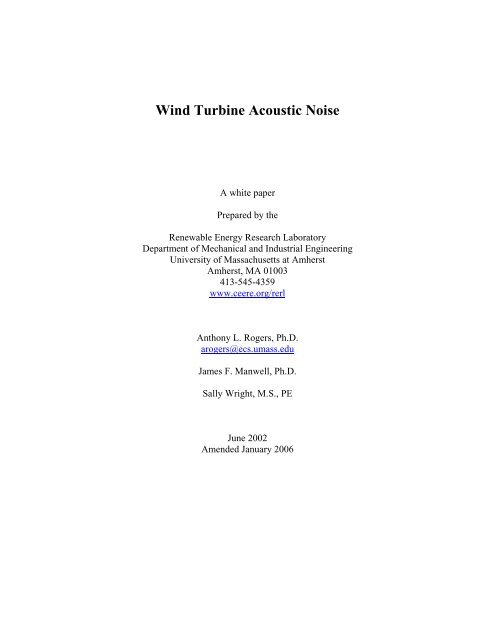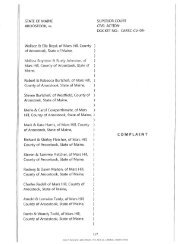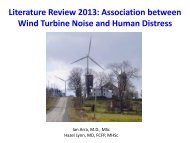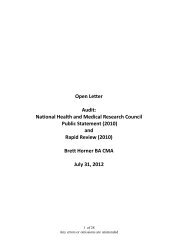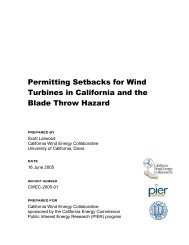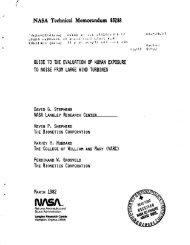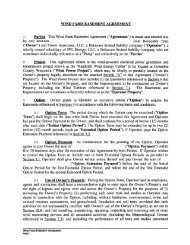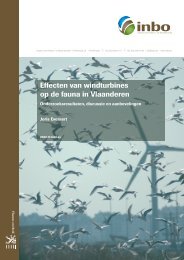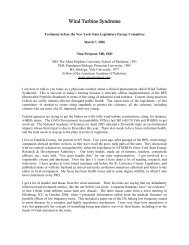Noise White Paper Outline - Minuteman Wind, LLC
Noise White Paper Outline - Minuteman Wind, LLC
Noise White Paper Outline - Minuteman Wind, LLC
You also want an ePaper? Increase the reach of your titles
YUMPU automatically turns print PDFs into web optimized ePapers that Google loves.
<strong>Wind</strong> Turbine Acoustic <strong>Noise</strong>A white paperPrepared by theRenewable Energy Research LaboratoryDepartment of Mechanical and Industrial EngineeringUniversity of Massachusetts at AmherstAmherst, MA 01003413-545-4359www.ceere.org/rerlAnthony L. Rogers, Ph.D.arogers@ecs.umass.eduJames F. Manwell, Ph.D.Sally Wright, M.S., PEJune 2002Amended January 2006
Introduction<strong>Wind</strong> turbines generate sound via various routes, both mechanical and aerodynamic. Asthe technology has advanced, wind turbines have gotten much quieter, but sound fromwind turbines is still an important siting criterion. Sound emissions from wind turbinehave been one of the more studied environmental impact areas in wind energyengineering. Sound levels can be measured, but, similar to other environmental concerns,the public's perception of the acoustic impact of wind turbines is, in part, a subjectivedetermination.<strong>Noise</strong> is defined as any unwanted sound. Concerns about noise depend on:1. the level of intensity, frequency, frequency distribution and patterns of the noisesource;2. background sound levels;3. the terrain between the emitter and receptor4. the nature of the receptor; and5. the attitude of the receptor about the emitter.In general, the effects of noise on people can be classified into three general categories:1. Subjective effects including annoyance, nuisance, dissatisfaction2. Interference with activities such as speech, sleep, and learning3. Physiological effects such as anxiety, tinnitus, or hearing loss.In almost all cases, the sound levels associated with wind turbines large & small produceeffects only in the first two categories, with modern turbines typically producing only thefirst. The third category includes such situations as work inside industrial plants andaround aircraft. Whether a sound is objectionable will depend on the type of sound (tonal,broadband, low frequency, or impulsive) and the circumstances and sensitivity of theperson (or receptor) who hears it. Because of the wide variation in the levels ofindividual tolerance for noise, there is no completely satisfactory way to measure thesubjective effects of noise or of the corresponding reactions of annoyance anddissatisfaction.Operating sound produced from wind turbines is considerably different in level andnature than most large scale power plants, which can be classified as industrial sources.<strong>Wind</strong> turbines are often sited in rural or remote areas that have a corresponding ambientsound character. Furthermore, while noise may be a concern to the public living nearwind turbines, much of the sound emitted from the turbines is masked by ambient or thebackground sounds of the wind itself.The sound produced by wind turbines has diminished as the technology has improved. Asblade airfoils have become more efficient, more of the wind energy is converted intorotational energy, and less into acoustic energy. Vibration damping and improvedmechanical design have also significantly reduced noise from mechanical sources.The significant factors relevant to the potential environmental impact of wind turbinenoise are shown in Figure 1 [Hubbard and Shepherd, 1990]. Note that all acoustictechnology is based on the following primary elements: Sound sources, propagation<strong>Wind</strong> Turbine <strong>Noise</strong> Issues Renewable Energy Research Laboratory Page 3
human ear's response to changes in sound, sound level meters are generally equippedwith filters that give less weight to the lower frequencies. As shown in Figure 3, there area number of filters that accomplish this:• A-Weighting: This is the most common scale for assessing environmental andoccupational noise. It approximates the response of the human ear to sounds ofmedium intensity.• B-Weighting: this weighting is not commonly used. It approximates the ear formedium-loud sounds, around 70 dB.• C-Weighting: Approximates response of human ear to loud sounds. It can be usedfor low-frequency sound.• G-Weighting: Designed for infrasoundThe weighting is indicated in the unit, e.g. measurements made using A-weighting areexpressed in units of dB(A). Details of these scales are discussed by Beranek and Ver[1992].Figure 3: Definition of A, B, and C Frequency Weighing Scales [Beranek and Ver, 1992]Once the A-weighted sound pressure is measured over a period of time, it is possible todetermine a number of statistical descriptions of time-varying sound and to account forthe greater community sensitivity to nighttime sound levels. Terms commonly used indescribing environmental sound include:• L 10 , L 50 , and L 90 : The A-weighted sound levels that are exceeded 10%, 50%, and90% of the time, respectively. During the measurement period L90 is generallytaken as the background sound level.• L eq : Equivalent Sound Level: The average A-weighted sound pressure levelwhich gives the same total energy as the varying sound level during themeasurement period of time. Also referred to as L A eq .• L dn : Day-Night Level: The average A-weighted sound level during a 24 hour day,obtained after addition of 10 dB to levels measured in the night between 10 p.m.and 7 a.m.<strong>Wind</strong> Turbine <strong>Noise</strong> Issues Renewable Energy Research Laboratory Page 7
Some characteristics of the human perception of infrasound and low frequency sound are:• Low frequency sound and infrasound (2-100 Hz) are perceived as a mixture ofauditory and tactile sensations.• Lower frequencies must be of a higher magnitude (dB) to be perceived, e.g. thethreshold of hearing at 10 Hz is around 100 dB; see Figure 5• Tonality can not be perceived below around 18 Hz• Infrasound may not appear to be coming from a specific location, because of itslong wavelengths.120Low frequency hearing threshold levels(German reference curve)Sound Pressure Threshold(dB)1008060402000 20 40 60 80 100 120Frequency (Hz)source: Moorhouse et al, 2005: Proposed criteria for the assessment of low frequency noise disturbanceFigure 5: Typical perception threshold of human ear for low frequencysound as a function of pressureThe primary human response to perceived infrasound is annoyance, with resultingsecondary effects. Annoyance levels typically depend on other characteristics of theinfrasound, including intensity, variations with time, such as impulses, loudest sound,periodicity, etc. Infrasound has three annoyance mechanisms:• A feeling of static pressure• Periodic masking effects in medium and higher frequencies• Rattling of doors, windows, etc. from strong low frequency componentsHuman effects vary by the intensity of the perceived infrasound, which can be groupedinto these approximate ranges:• 90 dB and below: No evidence of adverse effects• 115 dB: Fatigue, apathy, abdominal symptoms, hypertension in some humans• 120 dB: Approximate threshold of pain at 10 Hz• 120 – 130 dB and above: Exposure for 24 hours causes physiological damage<strong>Wind</strong> Turbine <strong>Noise</strong> Issues Renewable Energy Research Laboratory Page 9
There is no reliable evidence that infrasound below the perception threshold producesphysiological or psychological effects.Sound from <strong>Wind</strong> TurbinesSources of <strong>Wind</strong> Turbine SoundThere are four types of sound that can be generated by wind turbine operation: tonal,broadband, low frequency, and impulsive:1. Tonal: Tonal sound is defined as sound at discrete frequencies. It is caused bycomponents such as meshing gears, non-aerodynamic instabilities interacting witha rotor blade surface, or unstable flows over holes or slits or a blunt trailing edge.2. Broadband: This is sound characterized by a continuous distribution of soundpressure with frequencies greater than 100 Hz. It is often caused by theinteraction of wind turbine blades with atmospheric turbulence, and alsodescribed as a characteristic "swishing" or "whooshing" sound.3. Low frequency: Sound with frequencies in the range of 20 to 100 Hz is mostlyassociated with downwind rotors (turbines with the rotor on the downwind side ofthe tower). It is caused when the turbine blade encounters localized flowdeficiencies due to the flow around a tower.4. Impulsive: This sound is described by short acoustic impulses or thumping soundsthat vary in amplitude with time. It is caused by the interaction of wind turbineblades with disturbed air flow around the tower of a downwind machine.The sources of sounds emitted from operating wind turbines can be divided into twocategories: 1) Mechanical sounds, from the interaction of turbine components, and 2)Aerodynamic sounds, produced by the flow of air over the blades. A summary of each ofthese sound generation mechanisms follows, and a more detailed review is included inthe text of Wagner, et al. [1996].Mechanical SoundsMechanical sounds originates from the relative motion of mechanical components andthe dynamic response among them. Sources of such sounds include:1. Gearbox2. Generator3. Yaw Drives4. Cooling Fans5. Auxiliary Equipment (e.g., hydraulics)Since the emitted sound is associated with the rotation of mechanical and electricalequipment, it tends to be tonal (of a common frequency), although it may have abroadband component. For example, pure tones can be emitted at the rotationalfrequencies of shafts and generators, and the meshing frequencies of the gears.In addition, the hub, rotor, and tower may act as loudspeakers, transmitting themechanical sound and radiating it. The transmission path of the sound can be air-borne or<strong>Wind</strong> Turbine <strong>Noise</strong> Issues Renewable Energy Research Laboratory Page 10
structure-borne. Air-borne means that the sound is directly propagated from thecomponent surface or interior into the air. Structure-borne sound is transmitted alongother structural components before it is radiated into the air. For example, Figure 6 showsthe type of transmission path and the sound power levels for the individual componentsfor a 2 MW wind turbine [Wagner, et al., 1996]. Note that the main source of mechanicalsounds in this example is the gearbox, which radiates sounds from the nacelle surfacesand the machinery enclosure.Figure 6: Components and Total Sound Power Level of a <strong>Wind</strong> Turbine, showingstructure-borne (s/b) and airborne (a/b) transmission paths [Wagner, 1996].Aerodynamic SoundsAerodynamic broadband sound is typically the largest component of wind turbineacoustic emissions. It originates from the flow of air around the blades. As shown inFigure 7, a large number of complex flow phenomena occur, each of which mightgenerate some sound. Aerodynamic sound generally increases with rotor speed. Thevarious aerodynamic sound generation mechanisms that have to be considered are shownin Table 1 [Wagner, et al., 1996]. They are divided into three groups:1. Low Frequency Sound: Sound in the low frequency part of the sound spectrum isgenerated when the rotating blade encounters localized flow deficiencies due tothe flow around a tower, wind speed changes, or wakes shed from other blades.2. Inflow Turbulence Sound: Depends on the amount of atmospheric turbulence.The atmospheric turbulence results in local force or local pressure fluctuationsaround the blade.3. Airfoil Self <strong>Noise</strong>: This group includes the sound generated by the air flow rightalong the surface of the airfoil. This type of sound is typically of a broadband<strong>Wind</strong> Turbine <strong>Noise</strong> Issues Renewable Energy Research Laboratory Page 11
nature, but tonal components may occur due to blunt trailing edges, or flow overslits and holes.Figure 7: Schematic of Flow around a Rotor Blade [Wagner, 1996].Table 1: <strong>Wind</strong> Turbine Aerodynamic Sound Mechanisms [Wagner et al., 1996]Type or indication Mechanism Main characteristics & importanceLow-frequency soundSteady thickness noise;steady loading noiseUnsteady loading noiseInflow turbulence soundAirfoil self-noiseTrailing-edge noiseTip noiseStall, separation noiseLaminar boundary layernoiseBlunt trailing edge noise<strong>Noise</strong> from flow overholes, slits andintrusionsRotation of blades or rotation oflifting surfacesPassage of blades through towervelocity deficit or wakesInteraction of blades withatmospheric turbulenceInteraction of boundary layerturbulence with blade trailingedgeInteraction of tip turbulence withblade tip surfaceInteraction of turbulence with bladesurfaceNon-linear boundary layerinstabilities interacting with theblade surfaceVortex shedding at blunt trailingedgeUnstable shear flows over holes andslits, vortex shedding fromintrusionsFrequency is related to blade passingfrequency, not important at currentrotational speedsFrequency is related to blade passingfrequency, small in cases ofupwind rotors, though possiblycontributing in case of wind farmsContributing to broadband noise; notyet fully quantifiedBroadband, main source of highfrequency noise (770 Hz < f < 2kHz)Broadband; not fully understoodBroadbandTonal, can be avoidedTonal, can be avoidedTonal, can be avoided<strong>Wind</strong> Turbine <strong>Noise</strong> Issues Renewable Energy Research Laboratory Page 12
Infrasound from <strong>Wind</strong> TurbinesWhen discussing infrasound from wind turbines, it is particularly important to distinguishbetween turbines with downwind rotors and turbines with upwind rotors. Some earlywind turbines did produce significant levels of infrasound; these were all turbines withdownwind rotors. The downwind design is rarely used in modern utility-scale windpower turbines.Upwind rotors emit broad band sound emissions, which include low frequency sound andsome infrasound. Note that the “swish-swish” sound is amplitude modulation at bladepassing frequencies of higher frequency blade tip turbulence and does NOT contain lowfrequencies.One example of low frequency sound and infrasound from a modern turbine is shown inFigure 8 . The magnitudes of these are below the perception limits of humans, which areshown in Figure 5.Figure 8: Example of 1/3 octave sound spectra downwind of a Vestas V80. Theinfrasound levels (range marked by the arrow) are below human perception levelSound Reduction Methods for <strong>Wind</strong> TurbinesTurbines can be designed or retrofitted to minimize mechanical sound. This can includespecial finishing of gear teeth, using low-speed cooling fans and mounting components inthe nacelle instead of at ground level, adding baffles and acoustic insulation to thenacelle, using vibration isolators and soft mounts for major components, and designingthe turbine to prevent sounds from being transmitted into the overall structure. Efforts toreduce aerodynamic sounds have included [Wagner, et al., 1996] the use of lower tipspeed ratios, lower blade angles of attack, upwind rotor designs, variable speed operationand most recently, the use of specially modified blade trailing edges.Recent improvements in mechanical design of large wind turbines have resulted insignificantly reduced mechanical sounds from both broadband and pure tones. Today, the<strong>Wind</strong> Turbine <strong>Noise</strong> Issues Renewable Energy Research Laboratory Page 13
sound emission from modern wind turbines is dominated by broadband aerodynamicsounds [Fégeant, 1999].Sounds from Small <strong>Wind</strong> TurbinesSound is likely to be one of the most important siting constraints for small wind turbines.Small wind turbines (under 30 kW capacity) are more often used for residential power orfor other dedicated loads. These systems may be grid-connected or stand-alone systems.Due to the proximity of human activity, these applications could potentially result innoise complaints. Small wind turbines are in many cases louder than large turbines. Smallwind turbines may also operate at higher tip speeds or turned partially out of the wind(this is known as furling, and is a common power limiting mechanism for high winds).These operating modes may aggravate sound generation. It is not always easy to obtainreliable sound measurements from the manufacturers of smaller wind turbines, especiallyat the wind speeds that might be a concern. For all of these reasons it is important tocarefully consider sounds from small wind turbines. Below are three examples of studiesof sound levels from wind small turbines.A study of sound produced by a 10 kW Bergey wind turbine at Halibut Point State Parkin Rockport, MA, includes measured sound pressure levels under a variety of windconditions and at a variety of distances from the wind turbine base [Tech Environmental,1998]. The study showed that under some conditions the wind turbine sound at 600 feet(182 m) from the wind turbine base increased sound levels by 13 dB(A). The studyestimated that a buffer zone of 1,600 feet would be required to meet Massachusetts noiseregulations (note that this model has been redesigned since that installation, so currentmodels might not require as large a setback.) Finally, the study also mentioned that underhigh wind conditions in which the wind turbine sound was masked by the wind-inducedbackground sound, as determined by the broadband sound pressure levels, the windturbine could still be heard due to the presence of helicopter-like thumping sounds duringfurling. Similar sounds have been described coming from other small wind turbines[Gipe, 2001]. These low-frequency and periodic sounds are not included in the standardA-weighted sound pressure measurements prescribed in the MA DEP regulations.In another study, sound measurements were made by the National Renewable EnergyLaboratory on a 900 Watt wind turbine, the Whisper 40 [Huskey and Meadors, 2001].This wind turbine has a rotor diameter of 2.1 m (7 ft) and was mounted on a 30 ft tower.The rotor rotates at 300 rpm at low power. The rotation speed increases to 1200 rpm asthe rotor rotates out of the wind (“furls”) to limit power in high winds. This operationresults in a blade-tip speeds between 33 and 132 m/s. Figure 9 illustrates the soundpressure level (with the background sound removed) and the background sound levels ata distance of 10 meters (33 ft) from the wind turbine base. Between 6 and 13 m/s thesound pressure levels due to the operation of the turbine increased more than 13 dB. Thisis a very large increase in sound level and would be experienced as more than a doublingof the sound level. Moreover, it increased enough that the background sound level, whichalso increased with wind speed, was not enough to mask the wind turbine sound until thewind speed increased to over 13 m/s (30 mph).<strong>Wind</strong> Turbine <strong>Noise</strong> Issues Renewable Energy Research Laboratory Page 14
Figure 9: Measured sound power levels of a SouthwestWhisper 900 wind turbineIn the third study, the National Renewable Energy Laboratory [Migliore, 2003]performed acoustic texts on eight small wind turbines ranging from 400 watts to 100 kWin rated power, using procedures based on international standards for measurement anddata analysis, including wind speeds down to 4 m/s in most cases. A summary of theresults are shown in Figure 10, which shows a very wide variety of sound levels. Thisfigure illustrates that measurement in winds over 10 m/s are useful for some of theturbines considered.Sound measurement standards for small wind turbines: The IEC 61400-11 standard(described below under <strong>Noise</strong> Standards and Regulations) may not be adequate forestimating sound levels from some small wind turbines. For instance, in contrast to thebroad-band aerodynamic sounds from large wind turbines, some small wind turbinedesigns lead to irregular sounds that may be quite audible at higher wind speeds. Whereasthe IEC standard requires the measurements at 6-10 m/s, measurements a lower andhigher wind speeds should be included for small wind turbines. In addition, measurementstandards do not require the measurement of thumping sounds and other irregular soundsthat can be found objectionable. The possibility of irregular sounds and loud sounds inhigh-wind should be considered when siting small wind turbines in populated areas.<strong>Wind</strong> Turbine <strong>Noise</strong> Issues Renewable Energy Research Laboratory Page 15
Figure 10: Summary of NREL study of small wind turbine sound: sound pressure level vs.wind speed, with the sound recorded downwind from the turbine [Migliore, 2003]Factors that Affect <strong>Wind</strong> Turbine Sound<strong>Wind</strong> turbine generated sound that is perceived at any given location is a function ofwind speed, as well as turbine design, distance, ambient sound levels and various otherfactors, which are explored below.<strong>Wind</strong> Turbine Design and Sound EmissionsAll large, modern wind turbines available commercially today in the US are upwind,horizontal axis, variable pitch, and many have some variability of rotational speed. Thereare, however, other designs that have been used historically and may appear again insome form.Several basic design characteristics can influence sound emissions. <strong>Wind</strong> turbines mayhave blades which are rigidly attached to the hub and thence to the rotor shaft. Otherdesigns may have blades that can be pitched (rotated around their long axis). Some haverotors that always turn at a constant or near-constant speed while other designs mightchange the rotor speed as the wind changes. <strong>Wind</strong> turbine rotors may be upwind ordownwind of the tower. Other things being equal, each of these designs might havedifferent sound emissions because of the way in which they operate. In general, upwind<strong>Wind</strong> Turbine <strong>Noise</strong> Issues Renewable Energy Research Laboratory Page 16
otors as opposed to downwind rotors, lower rotational speeds and pitch control result inlower sound generation.Aerodynamic sound generation is very sensitive to speed at the very tip of the blade. Tolimit the generation of aerodynamic sounds, large modern wind turbines may limit therotor rotation speeds to reduce the tip speeds. Large variable speed wind turbines oftenrotate at slower speeds in low winds, increasing in higher winds until the limiting rotorspeed is reached. This results in much quieter operation in low winds than a comparableconstant speed wind turbine.Small wind turbines (under 30 kW) are also often variable-speed wind turbines. Thesesmaller wind turbine designs may even have higher tip speeds in high winds than largewind turbines. This can result in greater sound generation than would be expected,compared to larger machines. This is also perhaps due to the lower investment in soundreduction technologies in these designs. Some smaller wind turbines regulate power inhigh winds by turning out of the wind or “fluttering” their blades. These modes ofoperation can affect the nature of the sound generation from the wind turbine duringpower regulation.Sound PropagationIn order to predict the sound pressure level at a distance from source with a known powerlevel, one must determine how the sound waves propagate. In general, as soundpropagates without obstruction from a point source, the sound pressure level decreases.The initial energy in the sound is distributed over a larger and larger area as the distancefrom the source increases. Thus, assuming spherical propagation, the same energy that isdistributed over a square meter at a distance of one meter from a source is distributedover 10,000 m 2 at a distance of 100 meters away from the source. With sphericalpropagation, the sound pressure level is reduced by 6 dB per doubling of distance. Thissimple model of spherical propagation must be modified in the presence of reflectivesurfaces and other disruptive effects. For example, if the source is on a perfectly flat andreflecting surface, then hemispherical spreading has to be assumed, which also leads to a6 dB reduction per doubling of distance, but the sound level would be 3 dB higher at agiven distance than with spherical spreading. Details of sound propagation in general arediscussed in Beranek and Vers [1992]. The development of an accurate soundpropagation model generally must include the following factors:• Source characteristics (e.g., directivity, height, etc.)• Distance of the source from the observer• Air absorption, which depends on frequency• Ground effects (i.e., reflection and absorption of sound on the ground, dependenton source height, terrain cover, ground properties, frequency, etc.)• Blocking of sound by obstructions and uneven terrain• Weather effects (i.e., wind speed, change of wind speed or temperature withheight). The prevailing wind direction can cause differences in sound pressurelevels between upwind and downwind positions.• Shape of the land; certain land forms can focus sound<strong>Wind</strong> Turbine <strong>Noise</strong> Issues Renewable Energy Research Laboratory Page 17
A discussion of complex propagation models that include all these factors is beyond thescope of this paper. More information can be found in Wagner, et al. (1996). Forestimation purposes, a simple model based on the more conservative assumption ofhemispherical sound propagation over a reflective surface, including air absorption isoften used [International Energy Agency, 1994]:Lp= Lw− 10 log 10 22( πR ) −αRHere Lp is the sound pressure level (dB) a distance R from a sound source radiating at apower level, Lw , (dB) and α is the frequency-dependent sound absorption coefficient.This equation can be used with either broadband sound power levels and a broadbandestimate of the sound absorption coefficient (α = 0.005 dB per meter) or more preferablyin octave bands using octave band power and sound absorption data. The total soundproduced by multiple wind turbines would be calculated by summing up the sound levelsdue to each turbine at a specific location using the dB math mentioned above.An example of the sound that might be propagated from a singe large modern windturbine is shown in Figure 11. This example assumes hemispherical sound propagationand uses the formula presented above. In this case the wind turbine is assumed to be on a50 m tower, the source sound power level is 102 dB(A), and the sound pressure levels areat estimated at ground level.60Sound Pressure Level, dB(A)555045403530Turbine sound power = 102 dB(A)Sound absorption coefficient = 0.005 dB(A)/mTower height = 50 m0200400 600Distance from Turbine Tower, meters8001000Figure 11: Example of propagation of sound from a large wind turbineThe location of the receptor is also significant. Upwind of a wind turbine there may belocations where no sound is heard. On the other hand sound may be propagated moreeasily downwind.Ambient Sounds & <strong>Wind</strong> SpeedThe ability to hear a wind turbine in a given installation also depends on the ambientsound level. When the background sounds and wind turbine sounds are of the samemagnitude, the wind turbine sound gets lost in the background.Ambient baseline sound levels will be a function of such things as local traffic, industrialsounds, farm machinery, barking dogs, lawnmowers, children playing and the interaction<strong>Wind</strong> Turbine <strong>Noise</strong> Issues Renewable Energy Research Laboratory Page 18
of the wind with ground cover, buildings, trees, power lines, etc. It will vary with time ofday, wind speed and direction and the level of human activity. As one example,background sound levels measured in the neighborhood of the Hull High School in HullMassachusetts on March 10, 1992 ranged from 42 to 48 dB(A) during conditions inwhich the wind speed varied from 5 to 9 mph (2-4 m/s).Both the wind turbine sound power level and the ambient sound pressure level will befunctions of wind speed. Thus whether a wind turbine exceeds the background soundlevel will depend on how each of these varies with wind speed.The most likely sources of wind-generated sounds are interactions between wind andvegetation. A number of factors affect the sound generated by wind flowing overvegetation. For example, the total magnitude of wind-generated sound depends more onthe size of the windward surface of the vegetation than the foliage density or volume[Fégeant, 1999]. The sound level and frequency content of wind generated sound alsodepends on the type of vegetation. For example, sounds from deciduous trees tend to beslightly lower and more broadband than that from conifers, which generate more soundsat specific frequencies. The equivalent A-weighted broadband sound pressure generatedby wind in foliage has been shown to be approximately proportional to the base 10logarithm of wind speed [Fégeant, 1999]:L A, eq ∝ log 10The wind-generated contribution to background sound tends to increase fairly rapidlywith wind speed. For example, during a sound assessment for the Madison (NY)<strong>Wind</strong>power Project, a project in a quiet rural setting, the background sound was found tobe 25 dBA during calm wind conditions and 42 dBA when the wind was 12 mph (5.4m/s). Background sound generated during sound measurements on a small wind turbineare shown in the Figure 12 [Huskey and Meadors, 2001]. The graph includes alogarithmic fit to that data based on the model mentioned above.( U )Background Sound Pressure, Lp806040200ModelMeasurements0246 8 10<strong>Wind</strong> Speed, m/sFigure 12: Sample background noise measurementsas a function of wind speedSound levels from large modern wind turbines during constant speed operation tend toincrease more slowly with increasing wind speed than ambient wind generated sound. Asa result, wind turbine noise is more commonly a concern at lower wind speeds [Fégeant,1999] and it is often difficult to measure sound from modern wind turbines above wind1214<strong>Wind</strong> Turbine <strong>Noise</strong> Issues Renewable Energy Research Laboratory Page 19
speeds of 8 m/s because the background wind-generated sound masks the wind turbinesound above 8 m/s [Danish <strong>Wind</strong> turbine Manufacturers Association, 2002].It should be remembered that average sound pressure measurements might not indicatewhen a sound is detectable by a listener. Just as a dog’s barking can be heard throughother sounds, sounds with particular frequencies or an identifiable pattern may be heardthrough background sounds that is otherwise loud enough to mask those sounds. Soundemissions from wind turbines will also vary as the turbulence in the wind through therotor changes. Turbulence in the ground level winds will also affect a listener’s ability tohear other sounds. Because fluctuations in ground level wind speeds will not exactlycorrelate with those at the height of the turbine, a listener might find moments when thewind turbine could be heard over the ambient sound.<strong>Noise</strong> Standards and RegulationsThere are standards for measuring sound power levels from utility -scale wind turbines,as well as local or national standards for acceptable noise power levels. Each of these isreviewed here. As of this writing (February 2005), there are no sound measurementstandards for small wind turbines, but both the American <strong>Wind</strong> Energy Association andthe International Electrotechnical Commission (IEC) are working on future standards.Turbine Sound Power Measurement StandardsThe internationally accepted standard to ensure consistent and comparable measurementsof utility-scale wind turbine sound power levels is the International ElectrotechnicalCommission IEC 61400-11 Standard: <strong>Wind</strong> turbine generator systems – Part 11:Acoustic noise measurement techniques [IEC, 2002]. All utility-scale wind turbinesavailable today in the US comply with IEC 61400-11. It defines:• The quality, type and calibration of instrumentation to be used for sound and windspeed measurements.• Locations and types of measurements to be made.• Data reduction and reporting requirements.The standard requires measurements of broad-band sound, sound levels in one-thirdoctave bands and tonality. These measurements are all used to determine the sound powerlevel of the wind turbine at the nacelle, and the existence of any specific dominant soundfrequencies. Measurements are to be made when the wind speeds at a height of 10 m (30ft) are 6, 7, 8, 9 and 10 m/s (13-22 mph). Manufacturers of IEC-compliant wind turbinescan provide sound power level measurements at these wind speeds as measured bycertified testing agencies.Measurements of noise directivity, infrasound (< 20 Hz), low-frequency noise (20-100Hz) and impulsivity (a measure of the magnitude of thumping sounds) are optional.Measured sound power levels for a sampling of wind turbines are presented in Figure 13as a function of rated electrical power. The data illustrate that sound emissions from windturbines generally increases with turbine size. The graph also shows that wind turbine<strong>Wind</strong> Turbine <strong>Noise</strong> Issues Renewable Energy Research Laboratory Page 20
designers’ efforts to address noise issues in the 1990’s and later have resulted insignificantly quieter wind turbines than the initial designs of the 1980’s.130sound power level dB[A]1201101009080's90'sSWT's00'sLog. (80's)Log. (90's)sound power level = 22 LOG(D) + 72sound power level = 11 LOG (D) + 8280701 10 100 1000Diameter [m]Figure 13: Sample wind turbine measured sound power levelsCommunity Standards for Determining Acceptable Sound Pressure LevelsAt the present time, there are no common international noise standards or regulations forsound pressure levels. In most countries, however, noise regulations define upper boundsfor the noise to which people may be exposed. These limits depend on the country andmay be different for daytime and nighttime.For example, in Europe, as shown in Table 2, fixed noise limits have been the standard[Gipe, 1995].Country Commercial Mixed Residential RuralDenmark 40 45Germany(day) 65 60 55 50(night) 50 45 40 35Netherlands(day) 50 45 40(night) 40 35 30Table 2: <strong>Noise</strong> Limits of Sound Pressure Levels, L eq (in dB(A)) in VariousEuropean Countries<strong>Wind</strong> Turbine <strong>Noise</strong> Issues Renewable Energy Research Laboratory Page 21
In the U.S., although no federal noise regulations exist, the U.S. EnvironmentalProtection Agency (EPA) has established noise guidelines. Most states do not have noiseregulations, but many local governments have enacted noise ordinances to managecommunity noise levels. Examples of such ordinances for wind turbines are given in thelatest Permitting of <strong>Wind</strong> Energy Facilities Handbook [NWCC, 2002].The Massachusetts Department of Environmental Protection (DEP) regulates noiseemissions as a form of air pollution under 310 CMR 7.00, “Air Pollution Control.” Thesecan be found at http://www.mass.gov/dep/air/laws/7a.htm. The application of theseregulations to noise is detailed in the DEP’s DAQC Policy Statement 90-001 (February 1,1990). The regulation includes two requirements. First, any new broadband sound sourceis limited to raising noise levels no more than 10 dB(A) over the ambient baseline soundlevel. The ambient baseline is defined as the sound level that is exceeded 90% of thetime, the L 90 level. Second, “pure tones”, defined here as an octave band, may be nogreater than 3 dB(A) over the two adjacent octave bands. All these readings are measuredat the property line or at any inhabited buildings located within the property.It should be pointed out that imposing a fixed noise level standard may not prevent noisecomplaints. This is due to the changing of the relative level of broadband backgroundturbine noise with changes in background noise levels [NWCC, 2002]. That is, if tonalnoises are present, higher levels of broadband background noise are needed to effectivelymask the tone(s). In this respect, it is common for community noise standards toincorporate a penalty for pure tones, typically 5 dB(A). Therefore, if a wind turbinemeets a sound pressure level standard of 45 dB(A), but produces a strong whistling, 5dB(A) are subtracted from the standard. This forces the wind turbine to meet a standardof 40 dB(A).A discussion of noise measurement techniques that are specific to wind turbine standardsor regulations is beyond the scope of this paper. A review of such techniques is given inHubbard and Shepherd [1990], Germanisher Lloyd [1994], and Wagner, et al. [1996].Sample <strong>Noise</strong> Assessment for a <strong>Wind</strong> Turbine ProjectMuch of the interest in wind turbine noise is focused on the noise anticipated fromproposed wind turbine installations. When a wind turbine is proposed near a sensitivereceptor, a noise assessment study is appropriate; these studies will typically contain thefollowing four major parts of information:1. An estimation or survey of the existing ambient background noise levels.2. Prediction (or measurement) of noise levels from the turbine(s) at and near thesite.3. Identification of a model for sound propagation (sound modeling software willincludes a propagation model.)4. Comparing calculated sound pressure levels from the wind turbines withbackground sound pressure levels at the locations of concern.An example of the steps in assessing the noise anticipated from the installation of a windturbine according to the Massachusetts regulations follows.<strong>Wind</strong> Turbine <strong>Noise</strong> Issues Renewable Energy Research Laboratory Page 22
Ambient Background Levels: Ambient sound levels vary widely and are important forunderstanding the noise as well as complying with ambient-based regulations.Background sound pressure levels should be measured for the specific wind conditionsunder which the wind turbine will be operating. In this example it will be assumed thatmeasurements indicate that the L 90 sound pressure levels are 45 dB(A) at 8 m/s windspeed.Source Sound Levels: In order to calculate noise levels heard at different distances, thereference sound levels need to be determined. The reference sound level is the acousticpower being radiated at the source, and is not the actual sound pressure level as heard atground level. Reference sound levels can be obtained from manufacturers andindependent testing agencies. Measurements should be based on the standards mentionedabove. In this example it will be assumed that the turbine will be on a 50 m tower and hasa sound power level of 102 dB(A), as in the previous example of sound propagation froma wind turbine.Sound Propagation Model: Sound propagation is a function of the source soundcharacteristics (directivity, height), distance, air absorption, reflection and absorption bythe ground and nearby objects and weather effects such as changes of wind speed andtemperature with height. One could assume a conservative hemispherical spreadingmodel or spherical propagation in which any absorption and reflection are assumed tocancel each other out. More detailed models could be used that include the effects ofwind speed and direction, since sound travels more easily in the downwind direction;however, a conservative model will assume that all directions are downwind at sometime. If the hemispherical propagation model is used, then the data in Figure 11 showsthe noise levels in the vicinity of the turbine.Comparison of Calculated Sound Levels with Baseline Sound Levels: Calculated windturbine sound levels do not include the additional background ambient sound levels. Themathematical relationship governing the addition of dB(A) levels require that if theturbine sound level is no more than 9.5 dB(A) above the ambient noise level, then thetotal noise levels will be within 10 dB(A) of the ambient sound level. If the ambientsound level is 45 dB(A), then, under Massachusetts regulations, the turbine can generateno more than 54.5 dB(A) at locations of concern. It can be seen from Figure 11 that thesound from the wind turbine would not exceed that limit at all locations more than 75 m(250 ft) from the wind turbine.Conclusions and RecommendationsModern, utility-scale wind turbines are relatively quiet; still, when sited within residentialareas, noise is a primary siting constraint. The following are recommendations forstandards, regulations and siting practices:• Turbine Standards:o Utility-scale turbines: Any incentives to promote wind energy should beprovided only to turbines for which the manufacturer can provide noisedata based on IEC standards or for turbines which are to be located at siteswhere there will clearly be no problem.<strong>Wind</strong> Turbine <strong>Noise</strong> Issues Renewable Energy Research Laboratory Page 23
o Small turbines: national standards for small wind turbine technology ingeneral are needed. For noise in particular, sound levels should bemeasured at lower and higher wind speeds, in addition to those measuredunder the IEC standard. Any operation-mode-dependent, time-dependentand frequency-dependent components also need to be described. Thesestandards need to provide sound measures that provide an accuraterepresentation of issues of interest to potential listeners.• <strong>Noise</strong> Regulations:o Community noise standards are important to ensure livable communities.<strong>Wind</strong> turbines must be held to comply with these regulations. <strong>Wind</strong>turbines need not be held to additional levels of regulations.o For small wind turbines: Because of the wide variety of sound levels fromsmall wind turbines, blanket setback limits should not be set a priori.However, they should be examined carefully based on the technologyproposed.• <strong>Wind</strong> turbine siting practice:o In order to comply with state noise regulations and to fit withincommunity land use, the siting of wind turbines must take sound levelsinto consideration.o If a wind turbine is proposed within a distance equivalent to three timesthe blade-tip height of residences or other noise-sensitive receptors, anoise study should be performed and publicized.<strong>Wind</strong> Turbine <strong>Noise</strong> Issues Renewable Energy Research Laboratory Page 24
ReferencesAWEA (American <strong>Wind</strong> Energy Association), Procedure for Measurement of AcousticEmissions from <strong>Wind</strong> Turbine Generator Systems, Tier I – Standard 2.1 (1989),American <strong>Wind</strong> Energy Association, Washington, DC, 1989.Beranek, L. L. and Ver, I. L., <strong>Noise</strong> and Vibration Control Engineering: Principles andApplications, Wiley, New York, 1992.Danish <strong>Wind</strong> turbine Manufacturers Association, www.windpower.dk, 2002.Fégeant, O., “On the Masking of <strong>Wind</strong> Turbine <strong>Noise</strong> by Ambient <strong>Noise</strong>,” Proc.European <strong>Wind</strong> Energy Conference, Nice, France, March 1-5, 1999.Germanisher Lloyd, Regulation for the Certification of <strong>Wind</strong> Energy ConversionSystems, Supplement to the 1993 Edition, Hamburg, March, 1994.Gipe, P., <strong>Wind</strong> Energy Comes of Age, Wiley, New York, 1995.Golec, M., Golec, Z., Cempel, C., “<strong>Noise</strong> of <strong>Wind</strong> Power Turbine V80 in a FarmOperation”, Proceedings of the First international Meeting on <strong>Wind</strong> Turbine<strong>Noise</strong>: Perspectives for Control, Berlin, October 17-18, 2005.Goodman, N., "The Environmental Impact of <strong>Wind</strong>power Development in Vermont: APolicy Analysis," Proc. <strong>Wind</strong>power '97, AWEA, pp 299- 308, 1997.Hubbard, H. H. and Shepherd, K. P., "<strong>Wind</strong> Turbine Acoustics," NASA Technical <strong>Paper</strong>3057 DOE/NASA/20320-77, 1990.Huskey, A. Meadors, M., <strong>Wind</strong> Turbine Generator System Acoustic <strong>Noise</strong> Report for theWhisper H40 <strong>Wind</strong> Turbine, National <strong>Wind</strong> Technology Center, Boulder, CO,June 1, 2001.IEC (International Electrotechnical Commission), IEC 61400-11: <strong>Wind</strong> turbine generatorsystems – Part 11: Acoustic noise measurement techniques. Document No.88/166/FDIS. Publication of the IEC Central Office, Geneva Switzerland, 2002.International Energy Agency: Expert Group Study on Recommended Practices for <strong>Wind</strong>Turbine Testing and Evaluation, 4. Acoustics Measurements of <strong>Noise</strong> Emissionfrom <strong>Wind</strong> Turbines, 3. Edition 1994.International Organization for Standardization, ISO:7196, Frequency weightingcharacteristics for infrasound measurements, 1995Leventhall G, Notes on Low Frequency <strong>Noise</strong> from <strong>Wind</strong> Turbines with special referenceto the Genesis Power Ltd Proposal, near Waiuku NZ Prepared for Genesis Power/Hegley Acoustic Consultants, 4th June 2004, Surry UK. Available at:http://www.windenergy.org.nz/documents/2004/040604-LeventhallReport-LowFrequency.pdf<strong>Wind</strong> Turbine <strong>Noise</strong> Issues Renewable Energy Research Laboratory Page 25
Manwell et al., <strong>Wind</strong> Energy Explained, Wiley, Chichester, West Sussex, 2004Migliore, P. et al, 2003, Acoustic Tests of Small <strong>Wind</strong> Turbines October 2003. NREL:P. Migliore, J. van Dam, and A. Huskey. Available at:http://www.wind.appstate.edu/reports/NRELAcousticTestsofSmall<strong>Wind</strong>Turbines.pdfMoorhouse et al, 2005: Proposed criteria for the assessment of low frequency noisedisturbance February 2005 Contract no NANR45, Prepared for Defra by Dr.Andy Moorhouse, Dr. David Waddington, Dr. Mags Adams. University ofSalford, UK.National <strong>Wind</strong> Coordinating Committee, NWCC, Permitting of <strong>Wind</strong> Energy Facilities:A Handbook," RESOLVE, Washington, D. C, 2002. Available athttp://www.nationalwind.org/publications/permit/permitting2002.pdfNave, C..R. Hyperphysics: Sound and Hearing: Sound Intensity and Sound Pressure,http://hyperphysics.phy-astr.gsu.edu/hbase/hframe.html, Georgia State University,2005. Referenced January 18, 2006.Snow, D. J., Low frequency noise and vibrations measurement at a modern wind farm,Harwell Laboratory Energy technology Support Unit, 1997.Tech Environmental, Inc., Acoustical Analysis of Bergey <strong>Wind</strong> Turbine, Halibut PointState Park, A report prepared for the Massachusetts Department of EnvironmentalManagement, June 1998.Wagner, S., Bareib, R. and Guidati, G., <strong>Wind</strong> Turbine <strong>Noise</strong>, Springer, Berlin, 1996.<strong>Wind</strong>test, Report of acoustical emissions of a wind turbine generaotr system of the typeV-52-850kW 103 dBa, Report WT 2454/02, 2002.<strong>Wind</strong> Turbine <strong>Noise</strong> Issues Renewable Energy Research Laboratory Page 26


